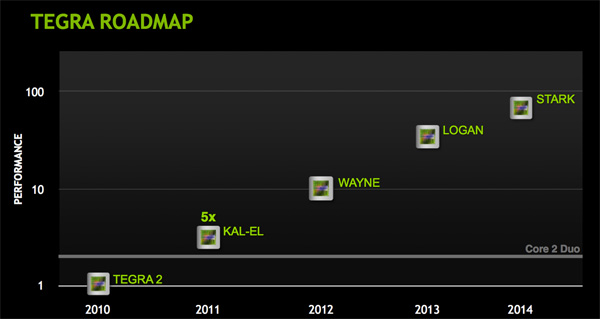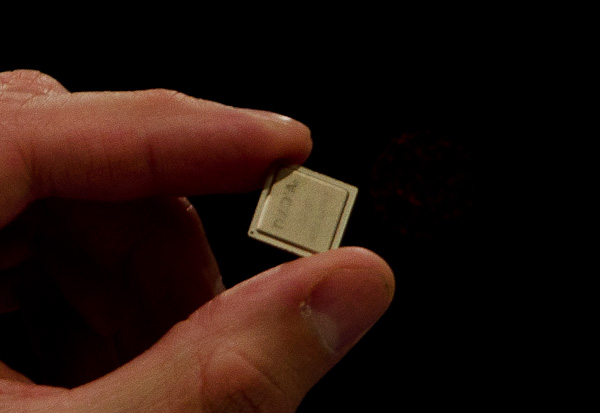NVIDIA's Kal-El Glowball Shows off Dynamic Lighting & Quad-Core Physics on a Tablet
by Anand Lal Shimpi on May 29, 2011 11:00 PM ESTI've warned both Qualcomm and TI that the danger they have to face in the SoC space going forward isn't just NVIDIA engineering, but NVIDIA marketing. Although too aggressive for my tastes at times, NVIDIA does know how to take a simple product release and turn it into an extremely polished technology launch. Even down to the materials NVIDIA shares with the press, to-date none of its competitors have built such pretty slides that make their way all over the web.
Obviously it's not just marketing with NVIDIA. After a rough start the Tegra 2 finally got real traction and has been the premier Android smartphone and tablet SoC since the beginning of the year. If you're buying an Android smartphone or tablet today, chances are the best option uses Tegra 2.
At MWC earlier this year NVIDIA announced its third applications processor, codenamed Kal-El. Kal-El will feature four ARM Cortex A9 cores with a shared 1MB L2 cache and MPE/NEON support (absent from Tegra 2). Kal-El will also fix the video decoder issue we've run into on Tegra 2 and should be able to play all high profile H.264 content with proper OS support. On top of all of that there's a faster GPU (12-core vs. 8-core plus higher throughput per core).

What does all of this have to do with NVIDIA's marketing? Today NVIDIA posted one of its famous tech demos running on a Kal-El reference platform to show off what's possible with the new SoC:
The video shows the output from a Honeycomb Kal-El development platform. In it you see techniques such as dynamic lighting and real-time physics. The latter uses all four of Kal-El's A9 cores, which you can see in action in the lower left of the video.
The Glowball demo is the perfect example of NVIDIA knowing how to execute on both the product and marketing sides when it comes to any major launch. Kal-El is still months away, but this is a great way to build excitement.
As always it's a pretty impressive tech demo but it's just that, a demo. As we've seen in the past, NVIDIA's tech demos are usually far more impressive than the actual titles we see released in the near term. After all, it's always easier to make a single scene look great vs. an entire game (not to mention that performance requirements go up as you add more dynamic characters in a given scene). But as a demo of what will be possible on a tablet by the end of the year, I can't complain.
NVIDIA said that Kal-El based devices are on track for release this holiday season. The original commitment was August 2011 but NVIDIA wouldn't be any more specific than to say that we may see some products launch before the holidays.

I suspect we may see more on Kal-El at Computex next week.












51 Comments
View All Comments
Rayb - Monday, May 30, 2011 - link
Dismiss Tegra 2 all you want, what matters is that it still is a very powerful SoC (1.5 years later) and the competitors are nowhere in the same number out of the gate.While Kal-El takes front stage at release, Tegra 2 becomes available as a second tier for a more affordable consumption in devices. What surprises me is the lack of competition form the established players (Qualcom, TI, Samsung and ST-Ericsson) in the ARM space, they've been showing their designs of dual cores for a while and still have managed to fumble the delivery.
http://androidcommunity.com/galaxy-s-ii-vs-qualcom...
Finally, after much waiting, the results of this new SoCs are nowhere close when expected to compete with Kal-El, if they planed to match it's performance. Just beating Tegra 2 by 25% with higer clocks is not going to cut it, if only the performance was doubled with the newer chip, although more is expected. So, back to the drawing board, it seems your projections are off kilter by a lot. Nvidia has an aggressive roadmap to introduce a new SoC every year, try to keep up!
dagamer34 - Monday, May 30, 2011 - link
Quad core is better than dual core in the same way that dual core is better than single core especially in a mobile device; work gets done faster so you can get to a low power state. If that statement weren't true, we'd only ever see single core chips.The only reason we don't have 24 core chips is because of the law of diminishing returns. Programming a multi-threaded application is quite difficult, and is highly dependent on the type of work being performed. Unless it's highly linear and parallel and scales with the number of cores (like video transcoding), there's going to be a sweet spot for the number of CPUs located on a die.
Lucian Armasu - Monday, May 30, 2011 - link
What could make parallel programming much easier? Do the chips need to work in a better way? Or do we need a new programming language to better optimize the code?I think we'll see a lot more core by the end of the decade.
metafor - Monday, May 30, 2011 - link
Some things just don't lend themselves to parallelism. A lot of algorithms and tasks are simply serially dependent. Those that are extremely parallel are generally better done on the GPU itself anyway.The only reason we've gone to 4-8 cores is because we've reached the end of scaling single-core performance on the desktop side. Realistic benefits of going beyond 2-4 cores even on the desktop are slight to nil in the average use-case, to be honest.
dagamer34 - Wednesday, June 1, 2011 - link
Not really. It's like trying to learn high school algebra and calculus at the same time, it doesn't really work that well. When one task has to come after another, more cores won't help.jkostans - Monday, May 30, 2011 - link
Why does nvidia put out crappy tech demos? I mean I'm sure that takes quite a bit of processing power but it looks ridiculous. Also, they are saying this is faster than a core 2 duo. Are you kidding me? Such marketing bull.Generic_User_#2 - Monday, May 30, 2011 - link
i must have missed that. i don't remember seeing/hearing a reference to core 2 duos.jkostans - Monday, May 30, 2011 - link
It's a horizontal line on the roadmap. My guess is they calculated CPU + GPU FLOP/s is some ridiculously optimistic way and its somehow twice that of a C2D E6300 (w/o a GPU involved on the PC side of course).All I know is my old single core Athlon XP system with 6800GT would still be loads faster than their "2X" C2D performance.
Rayb - Tuesday, May 31, 2011 - link
Don't loose sight of the fact that the chip is the size of a quarter and all of that performance can be squeezed into a smaller device running off battery power.Ain't technology great? You keep lugging around that system (Athlon XP system with 6800GT) while I do the same with a hand held device with this chip, ridiculous comparison indeed.
eddman - Monday, May 30, 2011 - link
And I think it looks very good. Opinions, opinions.